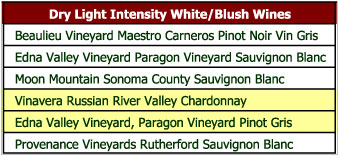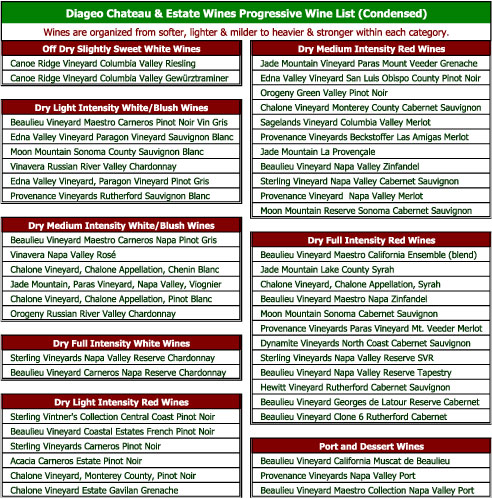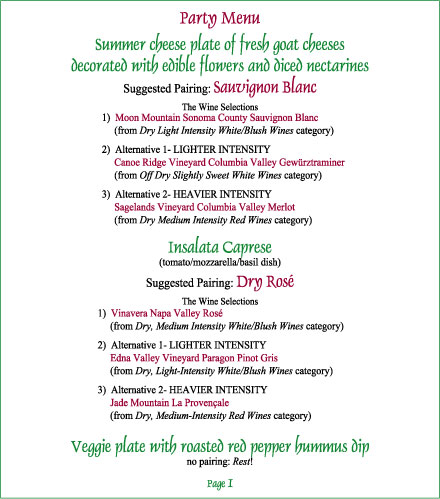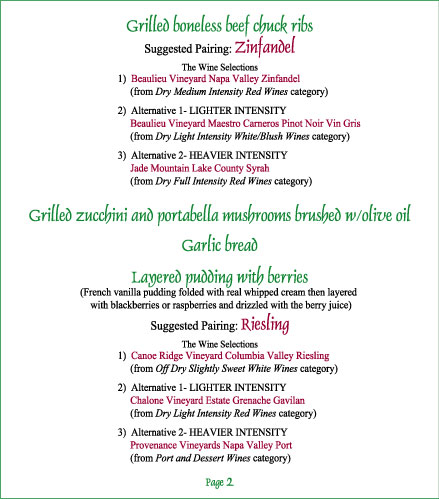Use a progressive wine list to please the palates of party members.
Each season, I intend to share my favorite party foods and several wine options to serve with a few of the courses, using what is called a progressive wine list.
Rather than grouping wines by color or varietal, progressive wine lists categorize wines by primary flavor characteristics, such as intensity and level of sweetness or dryness. Wines close together on the list tend to have similar tastes. For example, lighter reds like pinot noir and sangiovese can often be found next to each other on a list. Wines are organized from softer, lighter and milder to heavier and stronger within each category. It’s even possible that one grape varietal normally considered stronger than another could come before the so-called weaker grape if the specific wine’s individual intensity happened to be lighter. For instance, a light chardonnay might be listed before a medium-bodied pinot gris, although we normally think of pinot gris as one of the lightest whites.
Tim Hanni, Master of Wine, educator and consultant in the restaurant world, not only invented the concept of these flavor profile lists, now used widely by restaurants, hotels, parks and resorts worldwide, but also coined the term progressive wine list. He introduced his ideas over twenty years ago, and in 2001, formed WineQuest Solutions with several partners. WineQuest offers an online tool for the restaurant and hotel industry to easily create progressive wine lists comprising wines from their own libraries.Progressive Wine List
Please refer to the condensed version (below) of the progressive wine list developed by Wayne Ryan, National Education Manager for Diageo Chateau & Estate Wines (DC&E).
Located in Napa, California, DC&E owns over fifteen wineries, while the parent Diageo plc is the world’s leading premium drinks business with a collection of beverage alcohol brands across spirits, wine and beer categories.

The list, as with all progressive wine lists, is broken into categories of Off Dry Slightly Sweet Wines, Dry Light Intensity White/Blush Wines, Dry Medium Intensity White/Blush Wines, Dry Full Intensity White Wines, Dry Light Intensity Red Wines, Dry Medium Intensity Red Wines, Dry Full Intensity Red Wines and finally Port and Dessert Wines. I have eliminated many wines to save space, as the actual list is several pages long, but this summary shows enough to demonstrate how such a list works.
In my summer party menu, I have paired four of the courses with three wines each. First is a generally traditionally suggested wine for the recipe, followed by two alternatives, each from a different category of intensity.


When selecting your own alternative wines, refer to each wine’s tasting notes for further guidance as to what might pair well with the particular course. Just about every alternative wine I used from the different intensity/dryness categories had clues in its tasting notes to give me confidence I was making a promising selection, and I had confirmation from Wayne Ryan from Diageo, mentioned above.
1) Summer cheese plate with edible flowers and diced nectarines
Canoe Gewürztraminer tasting notes mentioned nectarine flavors.
Sagelands Merlot tasting notes said the wine pairs well with cheese plates.
2) Insalata Caprese (tomato/basil/mozzarella salad)
Edna Pinot Gris tasting notes indicated that lighter fare, such as hors’doeuvres and salads work well with the wine.
Jade La Provençale tasting notes stated that the wine is fresh and soft—I believe the softness will harmonize with and counteract the acidity in the tomatoes.
3) Beef ribs
BV Pinot Noir Vin Gris tasting notes showed that the wine is a delicious accompaniment to grilled meats.
Jade Lake County Syrah tasting notes suggested this syrah with marinated meats.
4) Layered pudding with berries
Chalone Grenache tasting notes show hints of raspberries.
I threw in the port, so good with desserts.
Maybe you don’t want to provide twelve different wines at your party! To reduce the number of wines, remember that any wine can really go with any food if the food is properly balanced. If the wine tastes bitter after a bite of the dish, try adding a little salt or a squeeze of lemon to the food to smooth out the taste of the wine, as suggested by Tim Hanni. But providing wines from several flavor categories is most likely to please nearly everyone.
You may decide to pair only three courses with wines, but I wanted to present enough examples to demonstrate the concept of pairing different intensity wines with the same foods. Another idea is to prepare foods with enough in common so that one wine from each of three flavor profiles might go nicely with each course, though you’ll have to do your homework!
----------------------------------------------------------
Look for future articles containing seasonal party menus with pairings.







